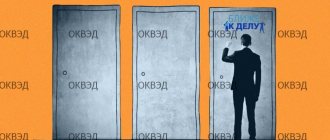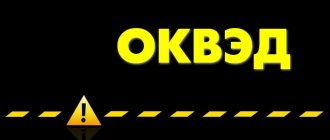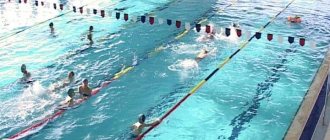In Russia, as you know, there are several tax regimes. They allow you to choose an acceptable tax burden for almost any organization, as well as for any individual entrepreneur (IP). Everything depends only on the activity that the organization or entrepreneur is engaged in. This article will discuss which codes from the All-Russian Classifier of Types of Economic Activities (OKVED) allow you to register a company with a simplified taxation system (STS) or switch to it.
Definition and essence of the OKVED classifier
Any newly registered organization must inform government agencies about the types of activities it intends to engage in. The same applies to companies that decide to change their type of activity to something else. For such purposes, a specialized OKVED reference book has been developed. It consists of 21 sections, each of them has its own letter designation. Sections include activity codes based on the digital coding of classes, subclasses, groups, subgroups and activities. That is, each code is a kind of location of an activity type in the hierarchy of the directory.
Important ! It is not necessary to use the full six-digit code to indicate in documents. It is enough to indicate the first four digits - a group of codes. This allows you not to specify all the codes that fall into this group; they will appear in the document automatically.
Definition and essence of the simplified taxation system
The simplified tax system is a taxation system in which the taxpayer, whether an individual entrepreneur or a legal entity, is exempt from basic taxes and pays only a single income tax or income tax minus expenses, depending on the chosen rate. And there is plenty to choose from:
- Simplified taxation system Income – 6%;
- Simplified taxation system Income minus expenses – 15%.
Also, regions of Russia may have their own tax rates that do not exceed those established by law. Their size for the tax simplified tax system Income and simplified tax tax income minus expenses cannot be less than 1% and 5%, respectively. These preferential conditions may be established by regional authorities for certain types of activities.
Important ! In some cases, under a simplified taxation system, it is required to pay VAT, but this is the exception rather than the rule.
Features of paying taxes under the simplified tax system
When choosing a simplified tax payment scheme for yourself, it is worth remembering that it only exempts you from transferring basic contributions to the treasury. Organizations will be exempt from taxes:
- at a profit;
- on property;
- Additional cost.
However, income from dividends and other debt obligations will be taxed even with the “simplification”. At the same time, remember that you will have to transfer personal income tax from your employees’ earnings to the state.
Individual entrepreneurs are not exempt from the portion of VAT that is paid when goods cross the Russian border, and is also transferred on the basis of property trust management or partnership agreements.
Transition to simplified tax system
According to the Tax Code of the Russian Federation, the transition to the simplified tax system is carried out at the beginning of the year. To do this, a representative of an organization or an entrepreneur must send a corresponding application to the tax authority no later than the first working day of the new year. In this case, one should be guided by the fact that the conditions for the simplified tax system are met. We will indicate what these conditions are below:
- Annual income limit: no more than 150 million rubles;
- Limitations on the average number of employees: no more than 100 people;
- Limitations on the residual value of fixed assets: no more than 150 million rubles;
- Limitations on the equity participation of other companies: the share of other organizations in the authorized capital does not exceed 25%.
The Russian Tax Code provides for the transition to a “simplified tax” only for certain types of activities established on the basis of the latest edition of OKVED.
OKVED codes that allow you to conduct activities on the simplified tax system
As mentioned earlier, when registering an LLC, JSC or individual entrepreneur, codes from the OKVED classifier are indicated in the application. They allow you to have a clear picture of the organization's activities. However, they can also be indicated in any “fire” case. Therefore, it is necessary to know which OKVED codes fall under the simplified tax system.
Let's understand the legislation.
The application of the simplified taxation system is regulated by the Tax Code of the Russian Federation, namely its Chapter 26.2. However, it does not list the OKVED codes for which the simplified tax system is allowed to be used.
Important ! There is no restriction on the use of the simplified tax system specifically according to OKVED as such. The only legislative act limiting the application of the simplified tax system by type of activity is Article 346.12 of the Tax Code of Russia.
Since the above article provides a small but exclusive list of organizations whose activities are prohibited by the use of the simplified tax system, it is easier to name the OKVED codes under which this list fits.
Declaration on the simplified tax system for individual entrepreneurs when conducting several types of activities
- The end of delays for online cash registers: who should use cash register systems from July 1 and what equipment to choose?
- How to manage document flow when using an online cash register?
- Does an LLC on the simplified tax system need to use cash register when receiving payment from an individual for a legal entity?
- The taxpayer “closed the individual entrepreneur”: does the inspectorate have the right to conduct an on-site inspection for the period after the loss of the individual entrepreneur status?
- The Federal Tax Service requires documents: which requests need to be answered and which can be ignored
- Transition to online cash registers on July 1, 2021: who will receive a new deferment
- From April 30 in 26 regions, when filling out payments for taxes and contributions, you must indicate a new UFK number
- The previous founding director has an accountable amount: what to do?
- How can an LLC issue a BSO under the simplified tax system from July 1, 2021 when providing services to the public?
- Do individual entrepreneurs on the simplified tax system need to use cash register systems in 2021 when providing services for the delivery of ready-made meal kits?
- The Federal Tax Service has updated indicators for calculating the probability of an on-site inspection
- New professional standard “Accountant”: what requirements for the profession does it introduce and who is obliged to apply it
- The Federal Tax Service reported what signs can be used to identify a suspicious founder from a potential counterparty
- Cash receipt: what details it should contain and in what format they should be indicated
- Does an LLC use the simplified tax system (income minus expenses) to allocate VAT to KUDiR?
- Transition to online cash registers from July 1, 2021: who will receive a new deferment
- How to explain the high share of tax deductions for VAT?
- The deadline for the audit has passed, but the Federal Tax Service requires an explanation for 2016: how to answer?
- The Federal Tax Service explained what to do if the inspection did not accept electronic documents
- The tax office sent a request with error code 9 for the VAT return: what to do?
The organization carries out two types of activities within the framework of the simplified tax system with the object “income minus expenses”, for one of them a loss was received. Is it possible to deduct the amount of loss for one type of activity from the total tax base?
April 27, 2012
Having considered the issue, we came to the following conclusion: In the Book of Accounting for Income and Expenses, in chronological order, based on primary documents, all business transactions for all types of activities carried out by the organization, related to the receipt of income and expenses, are reflected in the tax period. At the end of the tax period, based on these records, the overall total of the income received and expenses incurred are taken into account when determining the tax base.
Rationale for the conclusion: Chapter 26.2 of the Tax Code of the Russian Federation does not provide for the mandatory maintenance of separate accounting by type of activity for the purposes of calculating the tax paid when applying the simplified tax system. When carrying out several types of activities, an organization has the right to apply the simplified tax system, subject to compliance with the provisions of Art. 346.12, art. 346.13 Tax Code of the Russian Federation. Organizations using the simplified tax system, in accordance with Art. 346.24 of the Tax Code of the Russian Federation are required to keep records of income and expenses for the purpose of calculating the tax base for tax in the Book of Accounting of Income and Expenses of organizations and individual entrepreneurs using the simplified tax system (hereinafter referred to as the Book of Accounting of Income and Expenses), the form of which and the procedure for filling it out (hereinafter referred to as - Procedure) approved by order of the Ministry of Finance of Russia dated December 31, 2008 N 154n. The procedure does not provide for separate reflection in the Income and Expense Book of transactions for various types of activities carried out within the framework of the simplified tax system. In accordance with clause 1.1 of the Procedure, organizations maintain a Book of Income and Expenses, in which, in chronological order, based on primary documents, all business transactions for the reporting (tax) period are reflected in a positional manner. Taxpayers must ensure the completeness, continuity and reliability of recording the indicators of their activities necessary for calculating the tax base and the amount of tax (clause 1.2 of the Procedure). In accordance with the Procedure, Section I of the Income and Expense Book reflects income and expenses taken into account when calculating the tax base. At the end of the reporting (tax) period, the total amounts of income received by the organization are displayed, as well as the total amounts of expenses actually incurred related to the receipt of income. The tax period according to the simplified tax system is a calendar year (clause 1 of article 346.19 of the Tax Code of the Russian Federation). In accordance with paragraph 1 of Art. 346.23 of the Tax Code of the Russian Federation, taxpayers-organizations, after the expiration of the tax period, submit a tax return to the tax authorities at their location no later than March 31 of the year following the expired tax period (the form of the tax return and the procedure for filling it out were approved by Order of the Ministry of Finance of Russia dated June 22, 2009 N 58n) . In accordance with the Procedure for filling out a tax return, in section 2, line code 210 indicates the amount of income received by the taxpayer for the tax period; by line code 220 is indicated by the taxpayer, whose object of taxation is income reduced by the amount of expenses, the amount of expenses incurred during the tax period, determined in the manner established by Art. 346.16 Tax Code of the Russian Federation; line code 240 indicates the tax base for calculating tax for the tax period. The title page of the declaration indicates the code of the type of economic activity in accordance with the All-Russian Classifier of Types of Economic Activities OK 029-2001 (OKVED). If the taxpayer carries out several types of economic activities, then when filling out a tax return, the OKVED code is entered for one of the types of activities at the discretion of the taxpayer (letter of the Ministry of Finance of Russia dated March 28, 2007 N 03-11-05/53). Thus, the Income and Expense Accounting Book reflects the income and expenses taken into account when determining the tax base for all types of activities carried out by the organization. The total amounts of income and expenses for the tax period are reflected in the tax return. In this case, the organization should file a single tax return for the tax paid when applying the simplified tax system, which will reflect data on income and expenses for all types of activities carried out within the framework of the simplified tax system. At the same time, an organization can keep separate records for each type of activity, if it needs it for some purposes, using the data from the Income and Expense Book.
Answer prepared by: Expert of the Legal Consulting Service GARANT Galeeva Natalya
Response quality control: Reviewer of the Legal Consulting Service GARANT, professional accountant Svetlana Myagkova
Prohibited OKVED codes for the simplified tax system
As mentioned earlier, although there is no clear and direct connection with the ban on the simplified tax system, OKVED codes have an impact on the application of this system.
The correspondence of the codes to the regulated list of organizations that are prohibited is presented in the table. (click to expand)
| Organizations | OKVED code |
| Pawnshops | 64.92 “Providing loans and other types of credit” |
| Casino | 92.11 “Casino activities”; 92.12 “Activities of slot machine halls” |
| Organizations producing excisable goods | 12.00 “Production of tobacco products” 29.10 “Production of vehicles” 15.91 “Production of distilled alcoholic beverages” |
| Insurance companies and non-state pension funds | 67.20 “Supporting activities in the field of insurance and non-state pension provision” 66.01 “Life insurance and savings” 66.02 “Non-state pension provision” 66.03 “Other types of insurance” |
| Investment funds | 64.30 “Activities of investment funds and similar financial organizations” |
| Brokers | 66.12 “Brokerage activities in transactions with securities and commodities” |
| Notaries, lawyers | 74.11 “Activities in the field of law” |
Also, the simplified tax system is prohibited from being used by organizations whose activities include the extraction and sale of minerals (section B of the OKVED classifier). However, the ban is not imposed on the sale of common minerals.
Important ! It should be noted that when using certain OKVED codes, the ban may not occur. For example, when using OKVED code 29.10 in the production of motorcycles with a power of less than 150 hp, there is no prohibition on the simplified tax system, since such a vehicle is not an excisable product.
Trade
OKVED: Retail trade of footwear and clothing, etc. (UTII, Patent, USN)
(52.4) Other retail trade in specialized stores
(52.41) Retail trade of textiles and haberdashery
(52.41.1) Retail trade of textile products
(52.41.2) Retail sale of haberdashery
(52.42) Retail trade of clothing
(52.42.1) Retail trade of men's, women's and children's clothing
(52.42.2) Retail sale of underwear
(52.42.3) Retail sale of fur products
(52.42.4) Retail sale of leather clothing
(52.42.5) Retail sale of sportswear
(52.42.6) Retail trade of hosiery
(52.42.7) Retail sale of hats
(52.42.8) Retail sale of clothing accessories (gloves, ties, scarves, belts, suspenders, etc.)
(52.43) Retail trade of footwear and leather goods
(52.43.1) Retail sale of footwear
(52.43.2) Retail sale of leather goods and travel accessories
OKVED: Second hand, consignment store (UTII, Patent, USN)
(52.5) Retail sale of used goods in stores
(52.4) Other retail trade in specialized stores
OKVED code: Retail trade in building materials, paints, technical equipment (UTII)
(52.46) Retail sale of hardware, paints and glazing materials
(52.46.1) Retail sale of hardware
(52.46.2) Retail trade of paints, varnishes and enamels
(52.46.3) Retail sale of glazing materials
(52.46.4) Retail sale of materials and equipment for making crafts
(52.46.5) Retail trade of sanitary and technical equipment
(52.46.6) Retail trade of gardening equipment and tools
(52.46.7) Retail trade in construction materials not included in other groups
(52.46.71) Retail trade in timber
(52.46.72) Retail trade in bricks
(52.46.73) Retail trade of metal and non-metal structures, etc.
OKVED code: Retail trade of furniture, goods for office and home (UTII, Patent, USN)
(52.44) Retail trade of furniture and household goods
(52.44.1) Retail sale of furniture
(52.44.2) Retail sale of various household utensils, cutlery, dishes, glassware and ceramics; including porcelain and earthenware
(52.44.3) Retail sale of lamps
(52.44.4) Retail sale of drapes, tulle curtains and other household articles of textile materials
(52.44.5) Retail sale of wood, cork and wickerwork
If circumstances change, you can return the money with a guaranteed income of 10% per annum!
(52.44.6) Retail sale of household products and appliances not included in other groups
(52.48.1) Specialized retail trade of office furniture, office equipment, computers, optical instruments and photographic equipment
(52.48.11) Retail trade of office furniture
(52.48.12) Retail trade of office machinery and equipment
OKVED code: Retail trade of irons, microwave ovens, vacuum cleaners, electric kettles, literature, computers, etc. (UTII, Patent, USN)
(52.4) Other retail trade in specialized stores
(52.45) Retail trade of household electrical goods, radio and television equipment
(52.45.1) Retail sale of household electrical goods
(52.45.2) Retail sale of radio and television equipment
(52.45.3) Retail sale of audio and video equipment
(52.45.4) Retail sale of technical media (with and without records)
(52.45.5) Retail sale of musical instruments and music publications
(52.47) Retail trade of books, magazines, newspapers, stationery and stationery
(52.47.1) Retail sale of books
(52.47.2) Retail sale of newspapers and magazines
(52.47.3) Retail trade of stationery and stationery supplies
(52.48) Other retail trade in specialized stores
(52.48.1) Specialized retail trade of office furniture, office equipment, computers, optical instruments and photographic equipment
(52.48.12) Retail trade of office machinery and equipment
(52.48.13) Retail sale of computers, software and peripheral devices
(52.48.14) Retail trade in photographic equipment, optical and precision instruments
(52.48.15) Retail trade in telecommunication equipment
OKVED code: Other retail trade of non-food products (UTII, Patent, simplified tax system)
(52.48.2) Specialized retail sale of watches, jewelry, sporting goods, games and toys
(52.48.21) Retail trade in watches
(52.48.22) Retail sale of jewelry
(52.48.23) Retail sale of sporting goods, fishing equipment, camping equipment, boats and bicycles
(52.48.24) Retail sale of games and toys
(52.48.3) Specialized retail trade of non-food products not included in other groups
(52.48.31) Retail trade in household chemicals, synthetic detergents, wallpaper and floor coverings
(52.48.32) Retail trade of flowers and other plants, seeds and fertilizers
(52.48.33) Retail sale of pets and pet food
(52.48.34) Retail trade in souvenirs, folk arts and crafts, objects of worship and religious purposes, funeral supplies
(52.48.35) Retail trade in household liquid boiler fuel, bottled gas, coal, wood fuel, peat fuel
(52.48.36) Retail trade in philatelic and numismatic goods
(52.48.37) Retail sale of works of art in commercial art galleries
(52.48.38) Retail sale of pyrotechnics
(52.48.39) Specialized retail trade of other non-food products not included in other groups
OKVED code: Retail trade in products (UTII, Patent, USN)
(52.1) Retail trade in non-specialized stores
(52.11) Retail sale in non-specialized stores primarily of food products, including beverages, and tobacco products
(52.11.1) Retail sale of frozen foods in non-specialized stores
(52.11.2) Retail sale in non-specialized stores of non-frozen products, including drinks, and tobacco products
(52.12) Other retail trade in non-specialized stores
OKVED code: Commission and agency services (intermediary services) in retail trade (STS)
(74.84) Provision of other services
(93.05) Provision of other personal services
OKVED code: Online store, Internet trade (USN)
(52.61) Retail trade by order
(52.61.1) Retail postal (parcel) trade
(52.61.2) Retail trade carried out through teleshopping and computer networks (electronic commerce, including the Internet)
(72.60) Other activities related to the use of computer technology and information technology
(52.63) Other retail trade outside stores (STS, UTII)
This grouping includes:
- retail trade of any type of goods carried out by mobile means of distribution and distribution trade
OKVED code: Vending machines, payment terminals (Vending) (UTII, USN)
(52.63) Other retail trade outside stores
(74.84) Provision of other services
(72.60) Other activities related to the use of computer technology and information technology
Benefits for the simplified tax system according to certain OKVED
When registering an organization, determining the main type of activity and indicating additional ones, according to the OKVED directory, is very important. The whole point is that this or that activity can contribute to the establishment for the organization of both higher tax rates and benefits for certain types of taxes.
As for the simplified tax system, the correct definition of types of activities according to OKVED is also necessary here, since in different regions of the country there are more lenient tax conditions. For example, for construction companies in some areas there is a tax rate under the simplified tax system Income minus expenses equal to 5%, which is a significant argument in favor of developing a construction business and applying this tax.
Preferential conditions for insurance premiums under the simplified tax system also depend on the applied OKVED codes. For example, the following organizations on the simplified tax system can apply insurance benefits:
- Manufacturers of food products (OKVED codes: 10.01 – 10.08);
- Educational institutions (OKVED code – 85);
- Construction organizations (OKVED code – 41);
- Representatives of the chemical industry (OKVED code – 20)
- Processors of recyclable materials (OKVED code – 38);
- Sports organizations (OKVED codes: 93.11 and 93.19).
Only part of the OKVED preferential codes for insurance is listed above. A complete list of them is provided in the Tax Code of the Russian Federation, namely in subparagraph 5 of paragraph 1 of Article 427.
How to combine simplified taxation system with other modes
If an enterprise conducts several types of activities, it is possible to combine the simplified tax system with other tax regimes. “Simplified” is combined with UTII and PSN, but not with OSNO and Unified Agricultural Tax.
Let's say an enterprise sells building materials in a store and provides cargo transportation services. To reduce the tax burden, the store can be transferred to UTII or a patent for individual entrepreneurs, and transportation can be taxed according to a “simplified” tax system. Or vice versa - the choice depends on the success of the business areas. In those areas of activity where there are more expenses than income, the simplified tax system will be more profitable than other regimes.
Answers to frequently asked questions
Question N1: Hello! I am an individual entrepreneur. Can I use the simplified tax system if all the OKVED codes that I chose during registration allow this? Or there are additional restrictions. (click to expand)
Answer: In order to determine whether you have the right to keep accounting and tax records under the simplified tax system, it is necessary that the number of your employees does not exceed 100 people, and your income for nine months does not exceed 112.5 million rubles. Also, under the simplified tax system, the residual value of fixed assets cannot be more than 150 million rubles.








